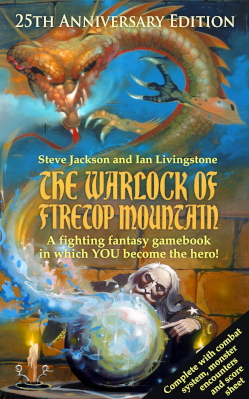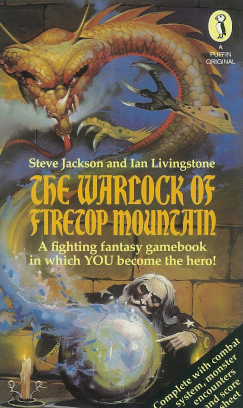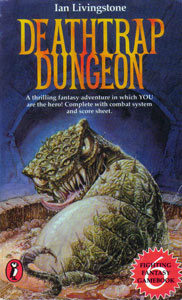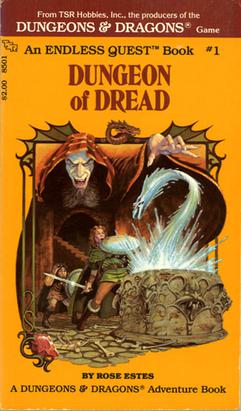
Star Frontiers is a science fiction role-playing game produced by TSR from 1982 to 1985. The game offers a space opera action-adventure setting.

Fighting Fantasy is a series of single-player role-playing gamebooks created by Steve Jackson and Ian Livingstone. The first volume in the series was published in paperback by Puffin in 1982.
A gamebook is a work of printed fiction that allows the reader to participate in the story by making choices. The narrative branches along various paths, typically through the use of numbered paragraphs or pages. Each narrative typically does not follow paragraphs in a linear or ordered fashion. Gamebooks are sometimes called choose your own adventure books or CYOA after the influential Choose Your Own Adventure series originally published by US company Bantam Books. Gamebooks influenced hypertext fiction.

Titan: The Fighting Fantasy World is a book in the Fighting Fantasy series of children's role-playing gamebooks, first published by Puffin Books in 1986. Although credited to Steve Jackson and Ian Livingstone, it was actually written by Marc Gascoigne, although mostly based on locations, characters and events already described in other books in the series. It is written in the manner of an encyclopedia about the fantasy world of Titan, in which the majority of Fighting Fantasy gamebooks are set.
Steve Jackson is a British game designer, writer, game reviewer and co-founder of UK game publisher Games Workshop.

The Warlock of Firetop Mountain is a single-player adventure gamebook written by Steve Jackson and Ian Livingstone, and illustrated by Russ Nicholson. Originally published by Puffin Books in 1982, the title is the first gamebook in the Fighting Fantasy series. It was later republished by Wizard Books in 2002, and Scholastic Books in 2017. As well as launching the Fighting Fantasy series, the gamebook inspired two direct sequels and five novels, and has been adapted into a board game, an audio drama and a video game.

Deathtrap Dungeon is a single-player adventure gamebook written by Ian Livingstone, and illustrated by Iain McCaig. Originally published by Puffin Books in 1984, the title is the sixth gamebook in the Fighting Fantasy series. It was later republished by Wizard Books in 2002.

The Warlock of Firetop Mountain is a Games Workshop adventure board game published in 1986, based on the Fighting Fantasy gamebook The Warlock of Firetop Mountain. The game can be played by 2-6 players. A typical game has a length of two hours.

Temple of Terror is a single-player role-playing game-book written by Ian Livingstone, illustrated by Bill Houston and originally published in 1985 by Puffin Books. It was later republished by Wizard Books in 2004. It forms part of Steve Jackson and Ian Livingstone's Fighting Fantasy series. It is the fourteenth in the series in the original Puffin series (ISBN 0-14-031832-1) and 19th in the modern Wizard series (ISBN 1-84046-528-X).

The Endless Quest books were three series of gamebooks. The first two series were released in the 1980s and 1990s by TSR, while the third series was released by Wizards of the Coast. Originally, these books were the result of an Educational department established by TSR with the intention of developing curriculum programs for subjects such as reading, math, history, and problem solving.

The Forest of Doom is a single-player adventure gamebook written by Ian Livingstone, and illustrated by Malcolm Barter. Originally published by Puffin Books in 1983, the title is the third gamebook in the Fighting Fantasy series, and the first of several to feature the character Yaztromo. It was later republished by Wizard Books in 2002. The gamebook was also adapted into a video game.

Caverns of the Snow Witch is a single-player roleplaying gamebook, written by Ian Livingstone, illustrated by Gary Ward and Edward Crosby and originally published in 1984 by Puffin Books. It was later republished by Wizard Books in 2003. It forms part of Steve Jackson and Ian Livingstone's Fighting Fantasy series. It is the 9th in the series in the original Puffin series (ISBN 0-14-031830-5) and 10th in the modern Wizard series (ISBN 1-84046-432-1).

House of Hell is a single-player adventure gamebook written by Steve Jackson, illustrated by Tim Sell and originally published in 1984 by Puffin Books. It was later republished by Wizard Books in 2002. It forms part of Steve Jackson and Ian Livingstone's Fighting Fantasy series. It is the 10th in the series in the original Puffin series (ISBN 0-14-031831-3) and 7th in the modern Wizard series (ISBN 1-84046-417-8). A digital version was developed by Tin Man Games for Microsoft Windows, Mac, Linux, Android and iOS.

Dungeoneer is the first of the three rule books that make up the Advanced Fighting Fantasy roleplaying game. It was written by Marc Gascoigne and Pete Tamlyn, illustrated by John Sibbick and was originally published in 1989. The system is based on Steve Jackson and Ian Livingstone's Fighting Fantasy series.

Appointment with F.E.A.R. is a single-player roleplaying gamebook written by Steve Jackson, illustrated by Declan Considine and originally published in 1985 by Puffin Books. It was later republished by Wizard Books in 2004. It forms part of Steve Jackson and Ian Livingstone's Fighting Fantasy series. It is the 17th in the series in the original Puffin series (ISBN 0-14-031922-0) and 18th in the modern Wizard series (ISBN 1-84046-527-1). A digital version developed by Tin Man Games is available for Android and iOS.

Trial of Champions is a single-player roleplaying gamebook, written by Ian Livingstone, illustrated by Brian Williams and originally published in 1986 by Puffin Books. It was later republished by Wizard Books in 2003.

Demons of the Deep is a single-player roleplaying gamebook written by Steve Jackson, illustrated by Duncan Smith and originally published in 1986 by Puffin Books. It forms part of Steve Jackson and Ian Livingstone's Fighting Fantasy series. It is the 19th in the series in the original Puffin series (ISBN 0-14-031921-2). There are currently no announced plans to republish the book as part of the modern Wizard series.

Eye of the Dragon is a single-player roleplaying gamebook written by Ian Livingstone, illustrated by Martin McKenna and published in 2005 by Wizard Books. It forms part of Steve Jackson and Ian Livingstone's Fighting Fantasy series. It is the 21st in the Wizard series. Eye of the Dragon was the first new Fighting Fantasy gamebook published by Wizard, although the book is an extended version of the adventure from Ian Livingstone's earlier book Dicing with Dragons rather than a completely original adventure. The book is made up of 407 references rather than the usual 400.

Advanced Fighting Fantasy (AFF) is a British roleplaying game based on the Fighting Fantasy and Sorcery! gamebooks, first published in 1989. Just as the gamebooks, AFF is set in the world of Titan. A second edition of AFF was published in 2011.
Steve Jackson's Sorcery! is a series of interactive fiction adventure video games developed by Inkle, based on the gamebook series of the same name by Steve Jackson. Part 1: The Shamutanti Hills was first released on May 2, 2013, and the series concluded with Part 4: The Crown of Kings on September 22, 2016. The games were originally developed for iOS, but have since been ported to Android, Microsoft Windows, OS X, Nintendo Switch, PlayStation 4, and Xbox One.
















